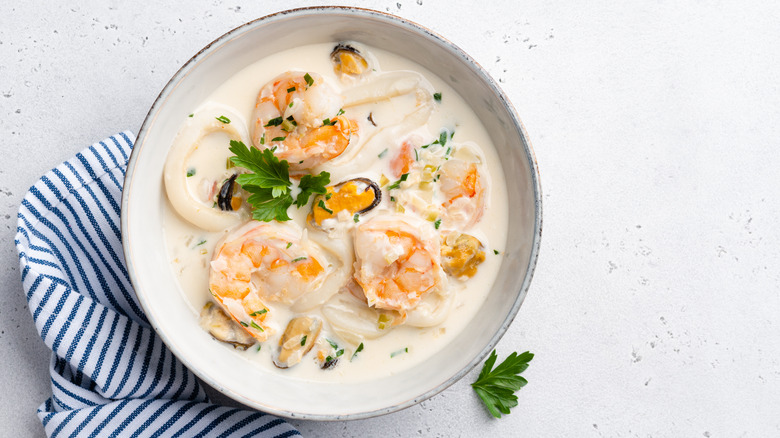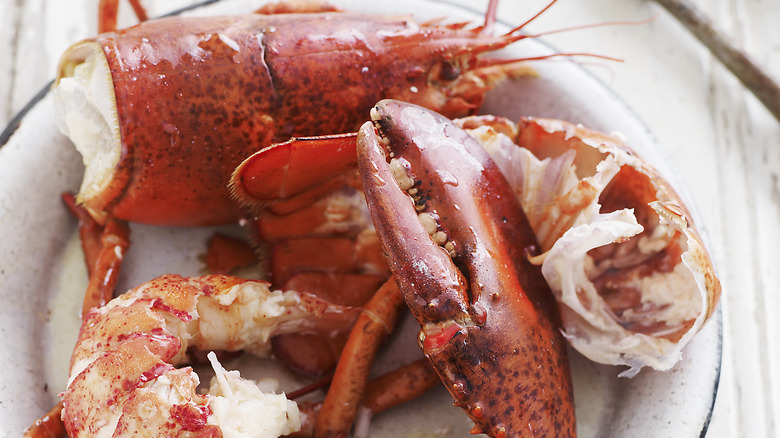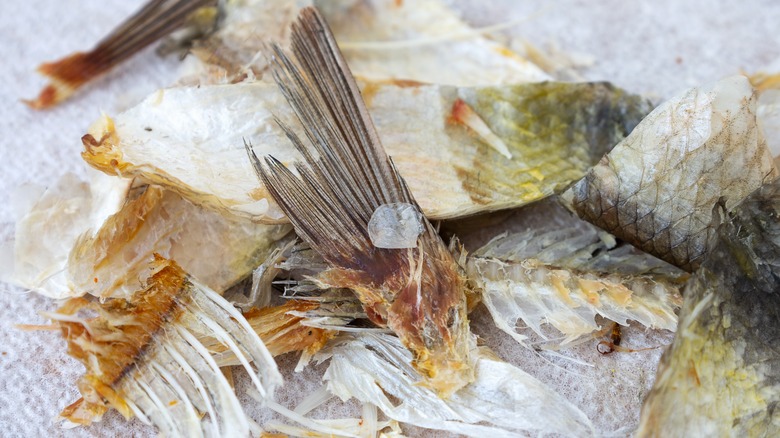Homemade Fish Stock Is Key For For Flavorful Chowder
Memorable and impactful dishes come from a complex, skillful laying of flavors, and one of the best ways to achieve this is with a good stock, which is not to be confused with broth. As MasterClass explains, stock is made from water, animal bones, meat, and vegetables — often seasoned — that is then simmered to form the liquid basis for soup, stews, sauces, and braises. Stock can also elevate grain-based dishes like risotto, couscous, pilaf, and paella when it stands in for water.
Every cook should know how to make basic stock, whether it's from vegetable scraps or a leftover chicken carcass, though it does take time. Seafood or fish stock, as Great British Chefs explains, comes together quickly and lends rich flavor to your cooking while teaching you how to reduce food waste. And it just happens to be the key for making the best homemade chowder you've ever had.
How to make fish stock
You can make homemade fish stock pretty easily. Great British Chefs explains that you can use the fish bones that come from white fish, like cod, bass, and flounder, though you should avoid oily fish, like salmon, tuna, or mackerel as they result in an undesirable greasy stock. You can save heads, bones, and tails from the fish you prepare at home, or you can ask your local seafood counter or fishmonger for trimmings, which they may even offer free of charge, per GBC. This is a great way to reduce food waste and use up as much of the animal as you can.
You don't need to stop at fish, either, when it comes to stock. Great British Chefs reminds us to save the shells from crabs, prawns, lobsters, and langoustines for this purpose. The Washington Post reminds us that stock made with shrimp and crawfish shells are one of the key components of Cajun and Creole cuisine, and that clam and mussel shells can also be used. No matter what you're using, be sure it's fresh (or thawed from frozen and used immediately), and simmered for a maximum of 30-45 minutes with your aromatics and other ingredients of choice (via GBC).
Cooking with fish stock
If you need guidance, Food Network (per Ina Garten) provides a recipe using shrimp shells, white wine, and thyme. Martha Stewart makes shellfish stock with lobster heads, cognac, and leeks, and while Andrew Zimmern is known for eating strange things, there's nothing fishy about his shellfish stock that calls for brandy, shrimp, and lobster shells. Adding booze to seafood stocks brightens and deepens its flavor (per Food Network). Plus, Foodprint writes that fish heads, collars, tails, and bones are commonly used in Asian cooking and enjoyed for their eating qualities and nutritious properties as they're rich in flavor, collagen, vitamins, and minerals.
Now that you know how easy fish stocks are to make, you'll never depend on bottle of clam juice again. See what wonders they work in recipes like Garten's hearty seafood chowder, or Jamie Oliver's sweetcorn and mussel chowder. Jasper White's New England fish chowder calls for a stronger fish stock, plus salt pork and buttery Yukon Gold potatoes. New England Today offers Julia Child's "Favorite Fish Chowder," adapted from The Way to Cook, which is traditionally thickened with crackers. With this many great chowder recipes, the hardest thing will be deciding whether you prefer yours red or white.


